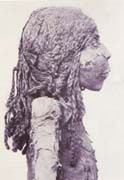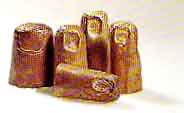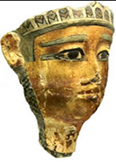BurialsMummificationThe Kushites practiced the process of mummification to preserve the bodies of their deceased rulers and royal persons. The first step in the mummification was to remove certain internal organs of the deceased that were thought to be unimportant parts of the body. These parts were not thrown away, but placed in canopic jars, or the "four sons of Horus", the Kushite gods that where thought to protect them. Duamutef protected the stomach, Happy protected the lungs, Qebehsenuef protected the intestines, and Imsety protected the liver. The brain was tossed out by pulling it through the nose holes, or through an opening that was cut in the left side of the deceased body.
However the heart was not removed, which was though to be the most sacred part of the body. By removing the most moisturous organs, the Kushites helped fasten the process of drying the body. They started by washing the body with natron and water. Natron is a type of salt obtained, from certain areas along the Nile Valley, to extract the water and moisture out of the deceased's body. Then the body was wrapped with linen soaked in natron and water solution. The wrapped body was kept for forty days to allow the natron time to remove the water and moisture. During this period the body was kept in a hot and dry environment so that the water pushed out by the natron would evaporate. The wrap was then removed and the body was washed with water and alcohol and anointed with a solution of resin. After that, the body was placed in an extended position and adorned with extensive jewelry. Gold masks were placed on the deceased's face. The hands were also adorned with gold crooks and bracelets. Fingers and toes were covered with gold, and rings covered the fingers of the mummy.
The body was finally wrapped with hundreds of yards of linen. During the process of wrapping, sacred amulets and texts were inserted within the folds of the linen. The wrapped body, or mummy, was then placed in a wooden coffin that has been made to look like the deceased with some abstraction. The wooden coffin was then fully covered with gold foil. Colored designs covered the surface of the coffin such as the designs for the winged god Horus, protector of the pharaohs. The wooden coffin was then put again inside a larger coffin also decorated to resemble the body of the deceased. The outer coffin was also inlayed with gold and decorated with religious motifs. Before the outer coffin was locked, sacred writings were included inside. Then the coffin was carried to the tomb chamber below the pyramid and placed on a bench; that is on a bed on top of a bench. The deceased belongings were included in the chamber to suit his/her soul in the after life. Farther Readings:
|


